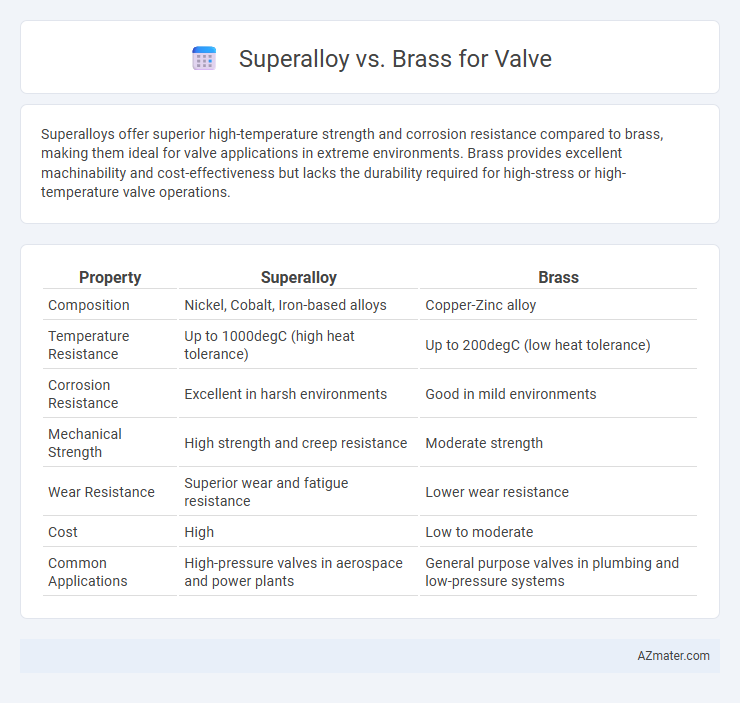Superalloys offer superior high-temperature strength and corrosion resistance compared to brass, making them ideal for valve applications in extreme environments. Brass provides excellent machinability and cost-effectiveness but lacks the durability required for high-stress or high-temperature valve operations.
Table of Comparison
| Property | Superalloy | Brass |
|---|---|---|
| Composition | Nickel, Cobalt, Iron-based alloys | Copper-Zinc alloy |
| Temperature Resistance | Up to 1000degC (high heat tolerance) | Up to 200degC (low heat tolerance) |
| Corrosion Resistance | Excellent in harsh environments | Good in mild environments |
| Mechanical Strength | High strength and creep resistance | Moderate strength |
| Wear Resistance | Superior wear and fatigue resistance | Lower wear resistance |
| Cost | High | Low to moderate |
| Common Applications | High-pressure valves in aerospace and power plants | General purpose valves in plumbing and low-pressure systems |
Introduction to Valve Materials: Superalloy vs Brass
Superalloys, known for their exceptional strength, corrosion resistance, and high-temperature performance, are commonly used in valve applications requiring durability under extreme conditions. Brass, an alloy of copper and zinc, offers excellent machinability, corrosion resistance in mild environments, and cost-effectiveness, making it suitable for general-purpose valves. Comparing superalloys and brass, superalloys excel in high-pressure, high-temperature valves found in aerospace and industrial sectors, while brass is preferred for residential plumbing and low-pressure applications due to its ease of fabrication and affordability.
Composition and Properties of Superalloys
Superalloys, primarily composed of nickel, cobalt, or iron with significant additions of chromium, aluminum, and titanium, exhibit exceptional high-temperature strength, corrosion resistance, and oxidation resistance, making them ideal for valve applications in extreme environments. Unlike brass, which is mainly an alloy of copper and zinc and provides good machinability and moderate corrosion resistance at lower temperatures, superalloys maintain structural integrity and mechanical performance under prolonged exposure to elevated temperatures and aggressive media. These properties contribute to superior durability, thermal stability, and pressure tolerance in valves manufactured from superalloys compared to those made from brass.
Key Characteristics of Brass in Valve Applications
Brass offers excellent corrosion resistance, machinability, and cost-effectiveness, making it a preferred choice for valve applications in low to moderate pressure environments. Its antimicrobial properties and good thermal conductivity enhance durability and performance in water and fluid handling systems. Brass valves exhibit reliable sealing and low friction, reducing wear and maintenance needs compared to other materials.
Strength and Durability Comparison
Superalloys exhibit superior strength and durability compared to brass, making them ideal for high-stress valve applications in extreme environments. Their resistance to thermal deformation and corrosion ensures prolonged operational lifespan under high pressure and temperature conditions. Brass valves, while easier to machine and cost-effective, lack the mechanical robustness and temperature tolerance of superalloys, limiting their use in demanding industrial settings.
Corrosion Resistance: Superalloy vs Brass
Superalloys offer superior corrosion resistance compared to brass, especially in high-temperature and aggressive chemical environments, making them ideal for critical valve applications in aerospace and chemical processing industries. Brass, while corrosion-resistant in freshwater and mild conditions, tends to corrode more rapidly when exposed to acidic or saline environments, limiting its use in harsh or high-pressure scenarios. Choosing superalloy valves ensures enhanced durability and longevity, reducing maintenance frequency and operational risks associated with corrosion-induced failures.
Temperature Tolerance and Thermal Stability
Superalloys exhibit superior temperature tolerance and thermal stability compared to brass, making them ideal for high-temperature valve applications exceeding 600degC (1112degF). Brass, with a melting point around 900degC (1652degF), deforms and loses strength under prolonged heat exposure, limiting its use in high-heat environments. The enhanced oxidation resistance and creep strength of superalloys ensure reliable valve performance in extreme thermal conditions, critical for aerospace and industrial gas turbines.
Cost Analysis: Superalloy vs Brass for Valves
Superalloy valves typically have higher upfront costs due to expensive raw materials and complex manufacturing processes, while brass valves are more cost-effective for standard applications with lower material expenses. Maintenance and replacement costs favor superalloys in high-temperature or corrosive environments because of their superior durability and resistance, reducing long-term operational expenses. Evaluating total lifecycle cost reveals brass valves are economical for moderate stress conditions, whereas superalloy valves justify their investment in critical, high-performance scenarios.
Machinability and Manufacturing Considerations
Superalloy valves offer superior strength and corrosion resistance but present significant challenges in machinability due to their hardness and tendency to work-harden, requiring specialized tooling and slower machining speeds. Brass valves provide excellent machinability with higher cutting speeds and easier fabrication, which reduces manufacturing time and costs, but they lack the high-temperature performance and durability of superalloys. Manufacturing considerations must balance the enhanced mechanical properties and longevity of superalloys against the cost-effectiveness and ease of machining brass for valve applications.
Typical Industries and Uses for Each Material
Superalloy valves are predominantly used in aerospace, power generation, and chemical processing industries due to their excellent high-temperature strength, corrosion resistance, and durability under extreme conditions. Brass valves find widespread application in plumbing, HVAC systems, and waterworks, valued for their machinability, corrosion resistance in mild environments, and cost-effectiveness. The choice between superalloy and brass hinges on operating environments, with superalloys suited for high-stress, high-temperature scenarios and brass preferred for general-purpose, low-pressure fluid control.
Choosing the Right Material: Factors to Consider
When selecting valve materials, consider factors like corrosion resistance, mechanical strength, operating temperature, and cost-effectiveness. Superalloys offer superior high-temperature strength and corrosion resistance, making them ideal for extreme environments, while brass provides good machinability and cost efficiency for moderate conditions. Evaluating the application's pressure, temperature, and chemical exposure ensures optimal performance and longevity by choosing between superalloy and brass valves.

Infographic: Superalloy vs Brass for Valve
 azmater.com
azmater.com